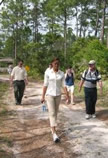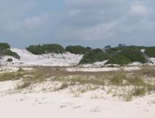
Go Wild in the Woods of Alabama
by Linda Aksomitis
 |
| Hiking
Pine Beach Trail in Bon Secour | Sound
filled the early morning-a loud hiss that was beyond my range of experience. The
closer I came to the lush growth of the park, the more it grew until it was the
buzzing of thousands. "What is that noise?" I asked, amazed that everyone
else seemed unperturbed by what I found to be an ear-piercing noise. It hurt.
"What?" said Andrew Hoffman, our guide from the US fish and Wildlife
Service, "oh, you mean those locusts." Locusts?
I'd always heard they were like grasshoppers, which I had plenty of experience
with, but no grasshopper I'd ever run into made this kind of hum! About then I
realized it was going to be an interesting hike through the Bon Secour National
Wildlife Refuge in Gulf Shores, Alabama. Locusts,
as it turns out, are large grasshoppers, with density-dependent polymorphism,
or some of their behaviors change when the swarm grows in number. Instead of being
quiet, well-behaved little insects eating everything in site, they become gregarious
and conspicuous, more like a group of teenage boys whose objective is to be noticed
on a Saturday night. Well, notice them I did! The
morning was hot, 90 plus degrees, but I was full of energy for the hike. My favorite
trees, the live oaks, shaded the Pine Beach Trail with their twisting, gnarly
limbs and lush green foliage. Their name comes from the fact that their leaves
persist until new ones appear, so they are never leafless as other oaks. In
the first mile on my way to Gator Lake, I encountered lots of incredible species
of plants and trees, many of them new to me. The Magnolias were just starting
to bloom, so their fragrant white flowers hid among the long branches of these
stately trees. The Red Basil, which attracts hummingbirds in the fall, was a small
shrub that caught my eye even though the red flowers weren't blooming yet. Pignut
hickory and Wild Olive were more new species for me, along with the muscadine,
a wild grape vine. While the
terrain was flat, the heat and high humidity made hiking a challenging enough
experience that several of our group slowed and fell behind. At Gator Lake the
water was filled with tall grasses-a heron stood perfectly still long enough for
me to take several photos. A ghost crab scurried through the shrubs, its white
body disappearing before I could focus on it.
Overhead
the osprey swooped through the sky, dropping down
to feed their nestlings. Great blue heron and cattle
egret were also active with newborn chicks. As we
left the lush foliage of the early part of the trail
behind, the sounds of locusts diminished and were
replaced with more the more familiar songs of birds
for the second mile of the trek.
Along the beach the sand was firm, so the tracks of wildlife were evident. While I didn't see the Loggerhead Sea Turtle, they are one of the endangered species in Bon Secour who often leave their prints for hikers to find. These nocturnal creatures come ashore to lay their eggs from May to September-with the peak occurring in June. They have changed little in 200 million years, although their existence has been threatened by coastal development in many areas.
A breeze blew in off Little Lagoon as the Pine Beach Trail wound its way past towards the Gulf of Mexico. Trees grew, to my surprise, in a permanent sway, bent in the direction of the perpetual winds. The sand was soft beneath my feet, so I searched for firm ground to make the hike a little less strenuous.
We passed what remained of the Perdue family farm, long since abandoned. The natural vegetation had twined through the foundation until much of it had already crumbled. Prickly pear cactus grew up through chunks of the building scattered during Hurricane Frederick's carnage in 1979. Attacking the Alabama Coast with 150 mph winds, Hurricane Frederick raged for twelve hours ripping apart property and battering the wildlife.
The two-mile trail ended in beautiful wind-sculpted dunes along the shores of the Gulf of Mexico. Long blades of grass protruded from the ever-shifting sand, growing in clumps that created patterns scattered along the shore. My feet sunk deeply into the sandy path, leaving imprint several inches deep.
 |
Dunes along Gulf Coast |
Following a child's urge, I took off my hiking shoes to let the sand trickle between my toes. It was smooth and hot. My feet were soon cooled, though, as I dipped them in the deep blue Gulf waters. Waves splashed against the shore while I stood looking out to sea at the end of Bon Secour's longest hiking trail.
The name Bon Secour comes from the French, and means "safe harbor." Here it was easy to see how appropriate that name was-as the unique habitats and wildlife were protected and preserved. Established June 9th, 1980, the park encompasses some of Alabama's last remaining undisturbed coastal barrier habitat. The total refuge consists of 6700 acres of coastal lands, ranging through beaches and dunes, to rolling pine-oak woodlands.
Numerous animals make it their home as well, although I wasn't lucky enough to see many. Raccoon, opossum, red fox, coyote, river otter, armadillo, alligator, flying squirrel and bobcat are some of the most common, and most are nocturnal, so hikers are only likely to discover their tracks.
The American Alligator found in Bon Secour generally range from 6-12 feet, although they can grow much larger. They're found throughout the refuge, although all I actually encountered were spots where the reptiles habitually slide from shore back into the water.
During the hike back to the trailhead Andrew shared more about Bon Secour through the seasons. From August to mid-October the fall bird migration brings many birds to the area. Peregrines and other raptors soar overhead, filling the Bon Secour skies. By mid-October hundreds of monarch butterflies stop on their migration, to draw nutrients from milkweed and other plants. The migratory songbirds bring spring to the area, arriving in mid-April, making Bon Secour a great stop for bird watchers.
Visitors to Bon Secour National Wildlife Refuge can hike and study nature throughout the year, making the area an ideal place for a winter vacation with its beautiful beaches and warm temperatures. In addition to photography, which is my favorite hiking activity, visitors may also fish in fresh or salt water, depending on their preference. I found lots to discover in my Bon Secour adventure, that's for sure!
|